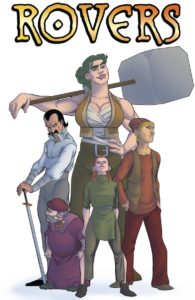
Rovers: Happenstance
Creator: Mick Beyers
Colorist: Joel Bartlett
Review by Jim Allegro

Rovers is not your typical fantasy comic book. There are no quests for ancient cursed items, no kings to unite warring lands against invading hordes, and no prophecies about chosen ones who must fulfill their destinies. This is a story about the rest of us – the average folk who are just trying to get by in a world where magic exists. Written and illustrated by Mick Beyers, Happenstance is an ambitious self-published trade paperback with three stand-alone comics about a band of traveling magicians, clerics, and mercenaries.
The ‘fantasy from below’ approach to storytelling is topical and intriguing. Comic books should reflect the times in which we live. And, in our times, with so much anguish directed at income inequality, it makes sense for creators to re-direct their attention away from the powerful and onto the ordinary. In this way, I liken Rovers to comics such as Renato Jones and Black Monday Murders. Beyers’s band of not-especially important rogues is a critique of the ‘one-percent,’ in this case the heroic knights and other elite who suck all the air out of the room of fantasy comics.
But this approach also comes with a challenge. The writer has the difficult task of making us care about these characters beyond the fact of their ordinariness. There is a reason fantasy focuses on prophecies and quests: they allow us to partake in something bigger than ourselves. Work-a-day battles against trolls lack that dramatic tension. Firefly is instructive here. The inspired science fiction-western drew us in because it was about priests, pilots, and other regular folk just trying to get by. But, it also allowed audiences to interact through these and other forgotten peoples with bigger problems: life on the losing end of a rebellion, government manipulation of its citizens, and so forth. I look forward to the bigger themes that Beyers sets his traveling band against as Rovers continues to grow and evolve.
The dialogue is another distinguishing characteristic of the comic. Beyers writes well, with clear plot points, likeable characters, and suspenseful endings. But the dialogue between the characters can get bogged down at times in mundane topics. Perhaps the emphasis on the cost of ale or securing a room at a tavern is on purpose. This is another way for the writer to focus attention on the ordinary. For better or worse, I thought of Pulp Fiction. Banal talk about the French name for hamburger was Tarantino’s way of dragging us down into the everyday. But, again, his choice served a higher purpose. The film juxtaposed the commonplace against the graphic to make the violence of the film all the more jarring. Likewise, the writer needs a more compelling/entertaining reason for these diversions. Until then, the narrative pace of Rovers can feel slow and over-written.
The artwork is by far the best part of the comic book. Beyers does a great job keeping the story moving with varied panel work and shifting perspectives. Generally, his characters are well-drawn, and his battle scenes are up to the standard of a professional comic book. The illustrations are presently limited to black-and-white sketches. However, the creators are soliciting support to have Joel Bartlett provide colors. Bartlett’s work on the cover and sample pages found on their Kickstarter page suggests that his effort will add considerable value to the book. I was particularly interested in his use of drab browns and greens that return us to the central theme of the Happenstance cycle. For this comic, it is enough to focus on the lives and experiences of ordinary people.
Verdict: Buy It!
Do you really want to waste all that time and money on another over-hyped Marvel event? Instead, why not support a wonderful self-published comic book such as Rovers: Happenstance? Indie comic books can take us to interesting and difficult places where mainstream comics rarely ever tread.

![[REVIEW] NO LOOKING BACK FOR WALLY WEST IN ‘FLASH FORWARD #1’](https://geekd-out.com/wp-content/uploads/2019/09/FF1-Featured-150x150.jpg)

